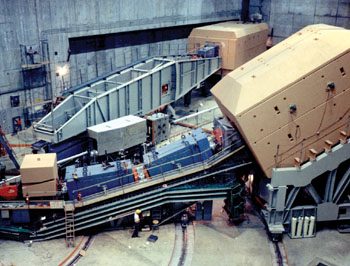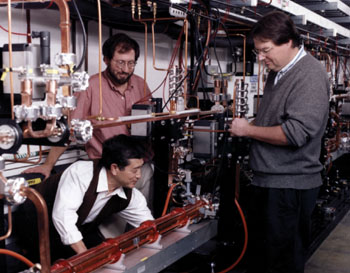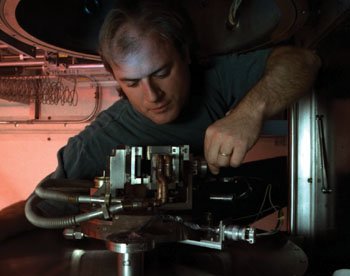The Stanford Linear Accelerator Center celebrates its 40th anniversary this year. Michael Riordan takes a look at its achievements and current research.

Some 50 km south of San Francisco, a long, low structure stretches for 3 km through the rolling, oak-studded hills behind the Stanford University campus to the base of the Santa Cruz mountains. This curious feature is the klystron gallery of the Stanford Linear Accelerator Center (SLAC) – by far the world’s largest electron microscope. It is one of the longest buildings on the surface of the Earth.

Ever since this powerful scientific instrument began operating in the mid-1960s, SLAC has been generating intense, high-energy beams of electrons and photons for research on the structure of matter. Physicists using its facilities have received three Nobel prizes for the discovery of the quarks and the tau lepton, both recognized today as fundamental building blocks of matter. Led by Wolfgang Panofsky and Burton Richter, its first two directors, the centre has also played a leading role in developing electron-positron storage rings and large “4p” detectors to observe subatomic debris spewing out from high-energy particle collisions.
Since the mid-1970s, other scientists have employed SLAC’s ultrabright X-ray beams to study the structure and behaviour of matter at atomic and molecular scales in the Stanford Synchrotron Radiation Laboratory (SSRL), now a division of SLAC. Molecular biologists, for example, have used these X-ray beams to determine the detailed structures of important biological molecules such as HIV protease and RNA polymerase. Still others have examined the behaviour of catalysts, semiconductors, superconductors, and the endless variety of advanced materials that are becoming increasingly essential in today’s high-tech industries.
SLAC is a national laboratory operated by Stanford University on behalf of the US Department of Energy (DOE), which supports its operations. The National Institutes of Health and the National Science Foundation provide additional funding for specific equipment and experiments. Use of SLAC’s facilities is available to qualified researchers from around the world; about 3000 users come to the centre each year from more than 20 countries to perform research in groups ranging in size from a few to several hundred scientists. In addition, SLAC has a staff of about 1400, of whom more than 300 are scientists involved in ongoing research. The results of all research performed at the laboratory are published openly in scientific and technical journals; no classified research is carried out on the premises.
Three Nobel prizes

The principal focus of research at SLAC is elementary particle physics – the field in which the centre has earned its three Nobel prizes. The first of these went to Richter, who shared the 1976 prize with Sam Ting for the discovery of the famous J/psi particle (which was eventually found to be made of charm quarks) two years earlier. In 1990, Jerome Friedman, Henry Kendall and Richard Taylor shared the prize for uncovering the quark substructure of protons and neutrons by studying deep-inelastic electron scattering from these targets in the late 1960s and early 1970s. SLAC’s third Nobel prize was awarded to Martin Perl in 1995 for his discovery of the tau lepton in the mid-1970s.
Stanford and SLAC physicists have also spearheaded the development of linear electron accelerators since the late 1940s. In the past two decades they have pioneered the development of linear electron-positron colliders. This work began in the early 1980s when SLAC upgraded its linear accelerator and converted it into the Stanford Linear Collider (SLC). Whereas CERN’s Large Electron-Positron (LEP) collider achieved higher energies, beam polarization proved to be the SLC’s forte, allowing researchers to probe subtle phenomena in the dominant Standard Model of particle physics. During the late 1980s and early 1990s, experiments at the SLC and LEP studying the decays of massive Z particles pinned down the exact number of light neutrino species and measured many key parameters of the Standard Model – especially the weak mixing angle – to high levels of precision. Since the shutdown of LEP in 2000, SLAC has been generating the highest-energy electron and positron beams in the world.

Working with colleagues from other high-energy physics laboratories in Japan, Europe and the US, SLAC physicists have developed accelerator technology for a next-generation instrument called the Next Linear Collider, which will be 30 km long. In January 2002, the US High-Energy Physics Advisory Panel recommended that US physicists play a leading role in an international effort to design and build such a linear collider.
Current research programme

Today the SLAC high-energy physics programme pivots around the PEP-II B-Factory. This facility was built during the mid-1990s under the leadership of SLAC’s current director Jonathan Dorfan as an upgrade of the original PEP storage ring. The electron-positron collider resides in a roughly circular tunnel that courses for 2200 m under one end of the 450 acre site. Inside the sophisticated 1200 ton BaBar particle detector, beams of electrons and positrons collide at unequal energies – 9.0 and 3.1 GeV – creating millions of pairs of B mesons per month. An international collaboration – involving about 550 physicists from more than 70 institutions in nine countries – is examining how these particles disintegrate and searching for subtle differences between matter and antimatter. During the summer of 2001, they uncovered conclusive evidence for such an asymmetry, known as CP violation, in certain specific decays of neutral B mesons. The BaBar collaboration is continuing to seek further examples of this rare phenomenon, which is widely believed to be responsible for the great preponderance of matter in the universe.
Physics research continues to thrive in SLAC’s cavernous End Station A. Since the landmark discovery of quarks there, nuclear and high-energy physicists have used this fixed-target experimental facility to study the substructure of nuclear matter in great detail, most recently with polarized beams of 50 GeV electrons that became available after the construction of the SLC. They are now using these beams to make an exacting measurement of the weak mixing angle by scattering polarized electrons from atomic electrons and measuring the extremely slight asymmetries that are expected to occur. These physicists are also developing high-energy beams of polarized photons to continue their research on the quark-gluon substructure of protons and neutrons.
Looking to the long-term future of high-energy physics research, a group of SLAC physicists and engineers has been working for several years on advanced particle acceleration techniques. In collaboration with university researchers, for example, the group is developing laser-induced plasmas that can boost the energy of an electron beam substantially over very short distances. This team has worked on “plasma lenses” to focus and accelerate particle beams.
SLAC has also been moving aggressively into the closely related fields of particle astrophysics and cosmology, using insights and techniques from particle physics to study the heavens. (In fact, the leading cosmological theory of inflation was conceived at SLAC in 1980 by Alan Guth, then a postdoctoral researcher.) Aided by scientists from universities and laboratories in Europe, Japan and the US, SLAC physicists are designing and building the Gamma-ray Large Area Space Telescope (GLAST), a high-resolution detector of energetic (up to about 300 MeV) photons scheduled for launch into Earth orbit in 2005. GLAST will employ sophisticated particle-detection and data-acquisition techniques that were originally developed for ground-based particle-physics experiments. Jointly funded by the DOE, the National Aeronautics and Space Administration and foreign scientific agencies, this satellite will examine sudden outbursts of gamma rays from black holes and other exotic astrophysical sources.
Synchrotron radiation research
Cutting-edge research into the atomic and molecular structure of matter occurs at SSRL. Using the SPEAR storage ring, which was adapted to function as a dedicated synchrotron radiation source, scientists generate intense X-ray beams from a circulating 3 GeV electron beam. Each year, more than 1600 scientists from many different disciplines use this radiation for research in such areas as designing new drugs, developing advanced information technologies (for example flat-panel computer displays and high-density microchips) and remediation of environmental contamination. Since its inception in 1974, SSRL has pioneered this burgeoning field of synchroton radiation research by developing equipment and experimental techniques commonly used today in nearly 50 such laboratories around the world. A major upgrade of the SPEAR facility that is currently under way will greatly increase the brightness of its X-ray beams and help to keep SSRL competitive with these other facilities.
Today, SLAC and SSRL are poised to begin building a next-generation facility, to be called the Linac Coherent Light Source, that will help to roll back the frontiers of X-ray research. Electrons accelerated in the final third of the linear accelerator will be compressed into tiny bunches that will then be directed through a special magnet array to produce laser-like X-ray beams of unparalleled brilliance. This unique instrument should open up new avenues of scientific research on such topics as ultrafast chemical reactions.
SLAC is also the world’s leader in developing high-power klystrons, which generate the microwaves used to accelerate electrons. Invented in 1937 at Stanford University, klystrons are also used to power radar arrays and for medical accelerators employed in cancer therapy. For decades, SLAC and the nearby Varian Corporation shared people, designs and ideas in a symbiotic relationship that has steadily advanced klystron technology. Medical accelerators are now a billion-dollar industry; they are used to give cancer treatments to more than 100,000 people every day. In addition, a software program called EGS (for Electron-Gamma Shower), developed by SLAC’s Ralph Nelson to simulate showers of subatomic particles, is used by hundreds of hospitals throughout the world to plan radiation dosages for cancer therapy.
Computers and telecommunications are other areas where SLAC research has strongly affected both the US and world economies. In December 1991, Paul Kunz expanded the then-fledgling World Wide Web (invented at CERN by Tim Berners-Lee) to North America, establishing the first US website at SLAC and making its popular SPIRES database easily accessible. The following year, another SLAC physicist developed an influential graphical Web browser to help communicate the reams of data and publications that are produced in the field every year.
Scientific education is ultimately one of SLAC’s most important goals. The thousands of students who have come to the laboratory to participate in advanced research have learned from working side by side with some of the best scientists on the planet, helping to push back the frontiers of their disciplines. They return to universities across the country and around the world – or take positions in industry or government – with a much better understanding of what it means to carry out scientific research.








